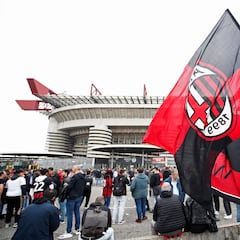What does ‘AC’ stand for in AC Milan? And why Milan not Milano?
The all-Italian 2023 Champions League semi-final pitted Inter against their city rival, but not everyone knows the origin of the name.


Tuesday night sees two European giants of football face off in the second leg of the Champions League. Both clubs come from the same city. They both share the same stadium, meaning home and away in this tie is played in rather familiar territory. The first game handed the advantage to Inter, but a two-goal deficit is not beyond the reach of their neighbourly rivals AC Milan.
**Follow Inter vs AC Milan in the Champions League semi-final live**
The history of AC Milan is a storied one, and the club owes its nomenclature to its English roots as well as a touch of historical circumstance, one very much linked to that of their rivals. Ahead of the game, I thought I’d delve into the tale behind the name of this iconic football institution.
💸🇮🇹 Inter take on their city rivals Milan at San Siro tonight, and they will do so without a ludicrously expensive sponsor on their shirt - but why?
— AS USA (@English_AS) May 16, 2023
Before you ask, I'm not complaining, it makes their shirt look even more fabulous...https://t.co/9UnMXVBbTn
Where AC Milan’s name came from?
Back in 1899, an English expatriate named Herbert Kilpin set the wheels in motion to establish a club in Milan. Originally known as Milan Foot-Ball and Cricket Club, this ambitious venture would lay the foundation for greatness. While the club claims December 16 as its official founding date, historical evidence points toward a more probable inception on December 13, a few days earlier.
Interestingly, AC Milan’s (Associazione Calcio Milan, translated to Milan Football Association) name carries a subtle nod to its English heritage. In an era when the club faced external pressures to conform to the Italian spelling of the city, Milano, it defiantly held onto its English roots. Despite the imposition during the fascist regime, the club retained the unique spelling that harkened back to its inception. It became a symbol of defiance, a constant reminder of the enduring spirit of the team.
You may also like:
The early years saw AC Milan establish themselves as a force to be reckoned with. In the first decade of existence, the club secured several prestigious trophies, including the Medaglia del Re (King’s Medal), the Palla Dapples, and the FGNI tournament. These triumphs were testament to the team’s prowess and set the stage for a remarkable journey. However, the road to success had its bumps along the way.
In 1908, internal disagreements over the signing of foreign players led to a dramatic split within the club. Out of this division emerged another Milan-based team, F.C. Internazionale Milano, giving birth to one of football’s most intense rivalries. This separation marked a challenging period for AC Milan, with an elusive domestic title remaining out of reach until the 1950–51 season.
We have one mission! ❤️🖤
— AC Milan (@acmilan) May 16, 2023
Un’unica missione! ❤️🖤
#RednBlack #UCL #InterMilan #SempreMilan pic.twitter.com/TIvvHpVz5Q
Related stories

The Derby della Madonnina: History and origin

How do the fans share San Siro?
The 1950s proved to be the start of what was to come, with five Scudetto titles and two continental trophies in that decade, although decline would be seen in the ‘80s, with a betting scandal adding a black mark to their proud name. Glory was soon to return either side of the turn of the new century.
Today, AC Milan has recaptured some of its magic and after lifting the Serie A title in 2022, now aims to add Champions League glory. Its name reflects the amalgamation of cultures, an English spelling that proudly defies conformity, and an Italian soul that beats within. Through triumphs and setbacks, AC Milan has remained a testament to the power of passion, unity, and the indomitable spirit of the Beautiful Game.